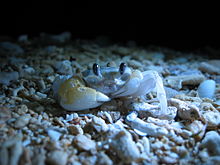- Ghost crab
-
"Ocypode" redirects here. For the harpy in Greek mythology, see Ocypete.
Ghost crabs 
Ocypode quadrata Scientific classification Kingdom: Animalia Phylum: Arthropoda Subphylum: Crustacea Class: Malacostraca Order: Decapoda Infraorder: Brachyura Family: Ocypodidae Genus: Ocypode
Weber, 1795 [1]Type species Cancer ceratophthalmus
Pallas, 1772Ghost crabs, also called sand crabs, are crabs of the genus Ocypode, common shore crabs in many countries. Characteristics of the genus include one claw being larger than the other, but this difference is not as marked as in male fiddler crabs.
Contents
Ecology
Ghost crabs dominate sandy shores in tropical and subtropical areas, replacing the sandhoppers that predominate in cooler areas.[2] They breathe through gills, which they periodically wet with seawater.[2] They must also return to the ocean to release their eggs, which develop into marine larvae.[2]
Adult ghost crabs dig deep burrows, comprising a long shaft with a chamber at the end, occasionally with a second entrance shaft. They remain in the burrow during the hottest part of the day, and throughout the coldest part of the winter.[2] They emerge mostly at night, to feed on mole crabs and coquina clams, although they will also eat a wide range of items, including carrion, debris and turtle hatchlings.[3]
Etymology
The name "ghost crab" derives from the animals' nocturnality and their pale colouration;[2] only O. gaudichaudii is brightly coloured.[4] The scientific name Ocypode is derived from the Greek roots ocy- ("fast") and ποδός (podos, "foot"), in reference to the animal's speed.[5]
Locomotion
The gait of O. ceratophthalmus alters as its speed increases. It can walk indefinitely using all four pairs of walking legs, occasionally alternating which side leads. At higher speeds, the fourth pair of legs is raised off the ground, and at the highest speeds, the crab runs, using only the first and second pairs of walking legs.[6]
Species
There are 28 species in the genus:[1]
- Ocypode africana De Man, 1881
- Ocypode brevicornis H. Milne-Edwards, 1837
- Ocypode ceratophthalmus (Pallas, 1772)
- Ocypode convexa Quoy & Gaimard, 1824
- Ocypode cordimanus Latreille, 1818
- Ocypode cursor (Linnaeus, 1758)
- Ocypode fabricii H. Milne-Edwards, 1837
- Ocypode gaudichaudii H. Mile-Edwards & Lucas, 1843
- Ocypode jousseaumei (Nobili, 1905)
- Ocypode kuhlii De Haan, 1835
- Ocypode longicornuta Dana, 1852
- Ocypode macrocera H. Milne-Edwards, 1852
- Ocypode madagascariensis Crosnier, 1965
- Ocypode mortoni George, 1982
- Ocypode nobili De Man, 1902
- Ocypode occidentalis Stimpson, 1860
- Ocypode pallidula Jacquinot, 1846
- Ocypode pauliani Crosnier, 1965
- Ocypode platytarsis H. Milne-Edwards, 1852
- Ocypode pygoides Ortmann, 1894
- Ocypode quadrata (Fabricius, 1787)
- Ocypode rotundata Miers, 1882
- Ocypode ryderi Kingsley, 1880
- Ocypode saratan (Forskål, 1775)
- Ocypode sinensis Dai, Song & Yang, 1985
- Ocypode simpsoni Ortmann, 1897
- Ocypode laevis Fabricius, 1798
- Ocypode minuta Fabricius, 1798
References
- ^ a b Sammy De Grave, N. Dean Pentcheff, Shane T. Ahyong et al. (2009). "A classification of living and fossil genera of decapod crustaceans" (PDF). Raffles Bulletin of Zoology Suppl. 21: 1–109. http://rmbr.nus.edu.sg/rbz/biblio/s21/s21rbz1-109.pdf.
- ^ a b c d e George Karleskint, Richard Turner & James Small (2009). "Intertidal communities". Introduction to Marine Biology (3rd ed.). Cengage Learning. pp. 356–411. ISBN 9780495561972. http://books.google.co.uk/books?id=0JkKOFIj5pgC&pg=PA377.
- ^ Pat Garber (2006). "Phantoms in the Surf: Ghost Crabs". Ocracoke Wild: A Naturalist's Year on an Outer Banks Island. Parkway Publishers. pp. 94–98. ISBN 9781933251318. http://books.google.co.uk/books?id=KF9lKLEgkt0C&pg=PA97.
- ^ Thomas G. Wolcott (1988). "Ecology". In Warren W. Burggren & Brian Robert McMahon. Biology of the land crabs. Cambridge University Press. pp. 55–97. ISBN 9780521306904. http://books.google.co.uk/books?id=RR09AAAAIAAJ&pg=PA91.
- ^ Keith Davey. "Ocypode cordimana (Family Ocypodidae)". SpeciesBank. Department of the Environment, Water, Heritage and the Arts. http://www.environment.gov.au/cgi-bin/species-bank/sbank-treatment.pl?id=77373. Retrieved November 5, 2010.
- ^ C. F. Herreid II & R. J. Full (1988). "Energetics and locomotion". In Warren W. Burggren & Brian Robert McMahon. Biology of the land crabs. Cambridge University Press. pp. 333–377. ISBN 9780521306904. http://books.google.co.uk/books?id=RR09AAAAIAAJ&pg=PA359.
Further reading
- Dennis DiClaudio (September 8, 2003). "The Nature of the Carolina Ghost Crab". Yankee Pot Roast. http://www.yankeepotroast.org/archives/2003/09/the_nature_of_t.html.
Categories:
Wikimedia Foundation. 2010.

